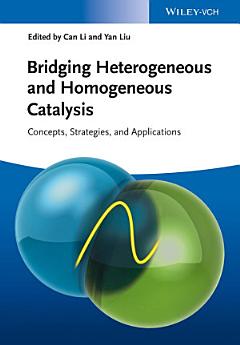Bridging Heterogeneous and Homogeneous Catalysis: Concepts, Strategies, and Applications
Can Li · Yan Liu
apl 2014 · John Wiley & Sons
E-book
656
Pages
reportLes notes et avis ne sont pas vérifiés. En savoir plus
À propos de cet e-book
There are two main disciplines in catalysis research -- homogeneous and heterogeneous catalysis. This is due to the fact that the catalyst is either in the same phase (homogeneous catalysis) as the reaction being catalyzed or in a different phase (heterogeneous catalysis). Over the past decade, various approaches have been implemented to combine the advantages of homogeneous catalysis (efficiency, selectivity) with those of heterogeneous catalysis (stability, recovery) by the heterogenization of homogeneous catalysts or by carrying out homogeneous reactions under heterogeneous conditions.
This unique handbook fills the gap in the market for an up-to-date work that links both homogeneous catalysis applied to organic reactions and catalytic reactions on surfaces of heterogeneous catalysts. As such, it highlights structural analogies and shows mechanistic parallels between the two, while additionally presenting kinetic analysis methods and models that either work for both homogeneous and heterogeneous catalysis.
Chapters cover asymmetric, emulsion, phase-transfer, supported homogeneous, and organocatalysis, as well as in nanoreactors and for specific applications, catalytic reactions in ionic liquids, fluorous and supercritical solvents and in water. Finally, the text includes computational methods for investigating structure-reactivity relations.
With its wealth of information, this invaluable reference provides academic and industrial chemists with novel concepts for innovative catalysis research.
This unique handbook fills the gap in the market for an up-to-date work that links both homogeneous catalysis applied to organic reactions and catalytic reactions on surfaces of heterogeneous catalysts. As such, it highlights structural analogies and shows mechanistic parallels between the two, while additionally presenting kinetic analysis methods and models that either work for both homogeneous and heterogeneous catalysis.
Chapters cover asymmetric, emulsion, phase-transfer, supported homogeneous, and organocatalysis, as well as in nanoreactors and for specific applications, catalytic reactions in ionic liquids, fluorous and supercritical solvents and in water. Finally, the text includes computational methods for investigating structure-reactivity relations.
With its wealth of information, this invaluable reference provides academic and industrial chemists with novel concepts for innovative catalysis research.
À propos de l'auteur
Can Li received his PhD degree from the Dalian Institute of Chemical Physics (China) in 1988, was promoted to full professor in 1993, and was elected as a member of the Chinese Academy of Sciences in 2003. He was appointed director of the State Key Laboratory of Catalysis at the Dalian Institute of Chemical Physics in 1998 and elected to the President of the International Association of Catalysis Societies in 2008. He is a member of the editorial board of more than 15 academic journals and has published more than 400 peer-reviewed papers, authorized 40 patents and delivered more than 60 invited and plenary lectures at national and international conferences. Under his supervision, more than 60 graduate students have obtained their PhD degrees. Among the prestigious awards he received are the International Catalysis Award, the National Award for Outstanding Young Scientists in China, and the HoLeungHoLee Prize. His research interests are physical chemistry, catalysis, environmental catalysis, chiral catalysis, in-situ characterization, resonance and time-resolved spectroscopy, and solar energy utilization (photocatalysis, photoelectrocatalysis and photovoltaic).
Yan Liu studied chemistry at Lanzhou University (China) and then moved to the State Key Laboratory of Organometallic Chemistry at the Shanghai Institute of Organic Chemistry to obtain his PhD degree under the supervision of Prof. Kuiling Ding in 2006. After three years of postdoctoral studies with Prof. Li Deng, Brandeis University (USA), he joined Prof. Can Li?s group at the State Key Laboratory of Catalysis at the Dalian Institute of Chemical Physics in 2010 as associate professor and was promoted to full professor in 2013.
Yan Liu studied chemistry at Lanzhou University (China) and then moved to the State Key Laboratory of Organometallic Chemistry at the Shanghai Institute of Organic Chemistry to obtain his PhD degree under the supervision of Prof. Kuiling Ding in 2006. After three years of postdoctoral studies with Prof. Li Deng, Brandeis University (USA), he joined Prof. Can Li?s group at the State Key Laboratory of Catalysis at the Dalian Institute of Chemical Physics in 2010 as associate professor and was promoted to full professor in 2013.
Donner une note à cet e-book
Dites-nous ce que vous en pensez.
Informations sur la lecture
Smartphones et tablettes
Installez l'application Google Play Livres pour Android et iPad ou iPhone. Elle se synchronise automatiquement avec votre compte et vous permet de lire des livres en ligne ou hors connexion, où que vous soyez.
Ordinateurs portables et de bureau
Vous pouvez écouter les livres audio achetés sur Google Play à l'aide du navigateur Web de votre ordinateur.
Liseuses et autres appareils
Pour lire sur des appareils e-Ink, comme les liseuses Kobo, vous devez télécharger un fichier et le transférer sur l'appareil en question. Suivez les instructions détaillées du Centre d'aide pour transférer les fichiers sur les liseuses compatibles.





